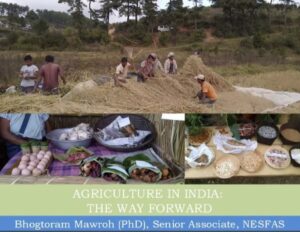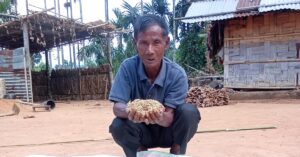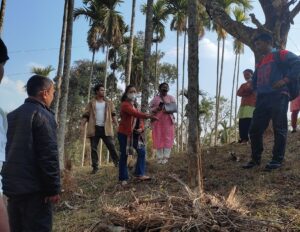Originally published in The Shillong Times
By Bhogtoram Mawroh, Stefan W Lyngdoh & Jakrimre Momin
On May 1, The Shillong Times carried a picture of three men carrying the carcass of a deer tied to the pole balanced across their shoulders. Below the picture was the message of the Divisional Forest Officer asking for information on the three individuals.
The particular animal (barking deer) is on the list of protected species and killing it is an offence punishable by law. This, however, was not always the case. In the initial hunting and gathering societies of human history, bush meat — or meat derived from wild animals for human consumption which includes invertebrates, amphibians, insects, fish, reptiles, birds and mammals — was an important source of protein in the diet.
The discovery of agriculture, which included domestication of animals, augmented food supply that reduced the need for hunting animals for food. It also introduced food plants like pulses which could supply the protein required by the body. Despite this, consumption of bush meat continued in a big way even to this day. Since bush meat has been a part of the tradition, to expect it to go away is highly unrealistic. At the same time, there are immense dangers, especially health related, to this trend continuing.
While bush meat can be a good source of protein, it also harbours immense health dangers. Bush meat could be a potential source of zoonotic disease. It is accepted that COVID-19 had its origin in bats. Apart from bats, wild boars, a favourite bush meat around the world, carry the hepatitis E virus (HEV) pathogen which causes Hepatitis E. Similarly, porcupine, monkey and hillock gibbon, wild birds, wild goats, wild cattle, bear, tiger, fox, elephant, rabbit and squirrel carry the pathogens of Ebola virus, HTLV-1, Salmonella spp, Listeria monocotytogenes, Leptospira interrogans, Trichinella, T. Gondii, Toxoplasma gondii, Mycobacterium tuberculosis, Mycobacterium spp and Leptospira spp, respectively. All of these are highly infectious to humans. The present COVID-19 is, as one article on the pandemic says, ‘a tip of the iceberg’.
One of the solutions for avoiding the dangers of bush meat consumption is to replace it with meat from domesticated animals. The demand for meat in Meghalaya, however, exceeds the domestic supply.
In 2017, it was reported that the state faced an annual shortage of 22,000 metric tonnes of fish. It is reasonable to assume that the situation has not changed much especially after the formalin scare. Similarly, in 2019 the state faced a shortage of 10,000 metric tonnes of pork meat with beef also being hit by low supply after an indefinite ban on the sale of beef in Khasi Hills, Jaintia Hills and Ri Bhoi districts to protest against the smuggling of cattle to Bangladesh. These cattle had been brought from outside the state. The state thus suffers from chronic shortages of meat supply.
Surprisingly, the answer to both the problems (shortage of supply and health as well as environmental concerns) lies in strengthening the Indigenous Food System (IFS).
Meghalaya’s IFS is based on the principle of diversity, in terms of the farming systems, practices and the agro-biodiversity it harbours. The participatory mapping exercise undertaken by NESFAS in 32 villages of Meghalaya and Nagaland revealed that the average number of food plants from the villages is 202. This included food plants belonging to the starchy staples, pulses, nuts and seeds, green leafy vegetables and fruits rich in Vitamin A, among others.
Ri Bhoi had the highest diversity with an average of 252 food plants and West Jaintia Hills had the lowest with 174 food plants. Among the food groups mentioned above Pulses is an important category.
Pulses include food plants like beans, peas, chickpeas, lentils and other species. In term of protein content, it rivals even meat. The protein content in chicken, beef, pork, fish (rohu) and mutton is 21.81 gm/100 gm, 19.82 gm/100 gm, 19.41 gm/100 gm, 19.71 gm/100g and 20.39 gm/100 gm, respectively. In comparison, the protein content from some of the pulses are, rice bean (19.97 gm/100 gm), soyabean (35.58 gm/100 gm), peas dry (20.43 gm/100 gm), Bengal gram (21.55 gm/100 gm) and lentil (24.35 gm/100 gm).
It clearly demonstrates that protein availability is either comparable or higher than meat. The other benefits of pulses is that they are very high in fibre, have low glycemic index, that is they contain carbohydrates that take the body longer to break down, thereby raising an individual’s blood sugar levels slowly which reduces the risks of diet related diseases. They lack cholesterol that is linked to heart-related diseases.
From the participatory mapping exercise it was found that pulses constituted less than 3 per cent of the food plants found in the study area. In absolute numbers though, numerous varieties are grown by the local communities.
In Khapmaw and Rasong villages in Mawkynrew block of East Khasi Hills, both of which recorded more than 200 food plants, jhum fields (lyngkha) and home gardens (kper) were the primary sources of pulses. The pulses grown in these two villages are phyrngop/common bean (Phaseolus vulgaris), rymbai saw/adzuki bean (Vigna angularis), rymbai ja/rice bean (Vigna umbellata), rymbai jhur/common bean (Phaseolus vulgaris), rymbai lyngkhap/hyacinth bean (Lablab purpureus) and unknown varieties like rymbai lphon pylon and rymbai maw.
Examples of pulses from other villages are buri/asparagus beans (Vigna unguiculata ssp. sesquipedalis), motor/peas (Pisum sativum), rymbai ktung (Glycine max), rymbai tari (Vicia faba) and many local landraces which have not been identified.
Khweng in Ri Bhoi had the highest number of pulses at 15, highlighting the immense diversity that exists in the local Indigenous Food System.
Surprisingly, when the daily diet of the community was assessed, pulses were among the missing food groups (along with nuts and seeds, dairy, egg etc) in both Meghalaya and Nagaland. Instead, meat (beef, chicken, pork, and fish) was amongst the most consumed food groups.
Meat does have some extra benefits which plants do not. Meat is a good source of fat, micro nutrients like iron and tends to contain a good balance of all the amino acids that body needs which some plants lack. Combining pulses with other plant-based protein sources such as cereal grains (wheat, millet, rice etc.), though, can improve protein quality due to their complementary amino acid profiles.
At the moment, however, there is an overwhelming dependence on meat as the source of protein and gross underutilization of the pulses that are found in great diversity. A healthy and well balanced diet is one which has diversity and includes meat and different type of vegetables and fruits.
Considering the low domestic supply of meat and the health and environmental dangers of consuming bush meat, there is a need to strengthen the IFS in the state. The diversity of pulses found within it can be encouraged to complement the protein requirements of locals. This will also reduce the burden on imports and enable that domestic meat and fish (a very healthy source of protein) production to be sufficient to meet the local demands. Such a strategy will have health, environmental and economic benefits for Meghalaya and its people.
(The authors are associated with NESFAS in various capacities)




Pingback: TIP Fellows & Mentors respond to the call of GLF2020 – The Indigenous Partnership